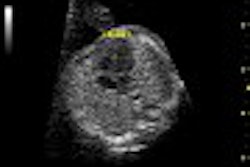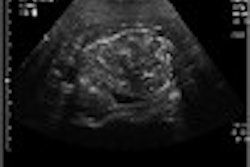More traditional methods of determining estimated fetal weight (EFW), such as abdominal palpation, may prove to be as accurate as ultrasonographic measurements for term birth weights greater than 4,000 grams, researchers reported at the 2003 American College of Obstetricians and Gynecologists meeting in New Orleans.
"With normal weight range or excessive weight range -- that is, macrosomic weight range -- clinical estimation by ‘laying on of hands’ at the time of admission may be just as accurate as a sonogram machine," according to Dr. Richard DeVeaux, lead researcher and chief of perinatology at Bronx-Lebanon Medical Center in New York City.
Macrosomia, or excessive birth weight, complicates more than 10% of all births, increasing the risk of birth trauma and the likelihood of cesarean deliveries. It is most often seen in diabetic mothers or those with cerebral gigantism.
Investigators enrolled 51 nondiabetic minority women in labor (at 37-41 weeks of gestation) and utilized standard ultrasound fetal biometric measurements to determine weight.
Measurements were taken of the fetal biparietal diameter, abdominal circumference, and femur length. All women had a standard physical examination including fundal height measurement, fetal station, and maternal weight.
According to the results, the actual mean birth weight was 3,238 grams (± 686 g standard deviation) versus the EFW by ultrasound of 3,077 grams (± 609 g SD; ± 8% of actual weight, p> 0.05). Using Hadlock’s formula, the fetal weight was 3,120 g (± 637 g SD; ± 8% of actual weight; p> 0.05).
The EFW using the Johnson formula was 3,879 g (± 506 g SD; ± 25% of actual weight, p < 0.001). For term birth weights greater than 4,000 g, the Johnson formula did not significantly differ (± 13% of actual weight), whereas the ultrasound (p=0.006) and Hadlock’s formula (p=0.01) weights significantly differed in predicting birth weight.
The group concluded that the EFW as predicted by ultrasound and Hadlock’s formula were comparable. "I’ve grown up in a generation of obstetricians that, as time has gone on, (has) relied more and more on ultrasound. But I think that recent work seems to indicate that the ‘laying on of hands’ isn’t so bad after all," DeVeaux said.
However, not everyone concurred with this conclusion. In a commentary, Dr. Gerard Nahum said that for fetal weight measurements of less than 4,000 grams, the Johnson formula seems "to do as well as guessing. The Johnson formula, which they are comparing ultrasound with, seems to not perform very well at all." Nahum is an associate clinical professor in the department of obstetrics and gynecology at Duke University School of Medicine in Durham, NC.
DeVeaux’s group acknowledged that the Johnson formula was less accurate, but may still have value in situations where clinical macrosomia is suspected.
Studies such as these shed light on the fact that there are no easy answers for pinpointing fetal birth weight, according to Dr. Ilan Timor, director of the ob/gyn ultrasound department at the New York University School of Medicine in New York City.
"Fetal weight estimations were, are, and will be a problem despite this study. It is naive to say that this simplistic study will solve the problem," Timor commented. "Today, even more sophisticated 3-D volume estimations are unable to come closer to solving this task."
By Jerry Ingram and Bruce SylvesterAuntMinnie.com contributing writers
July 10, 2003
Related Reading
Ultrasound scans identify high-risk fetuses in a low-risk population, April 8, 2003
Birth weight prediction equation beats ultrasound for accuracy, September 26, 2002
Copyright © 2003 AuntMinnie.com



















